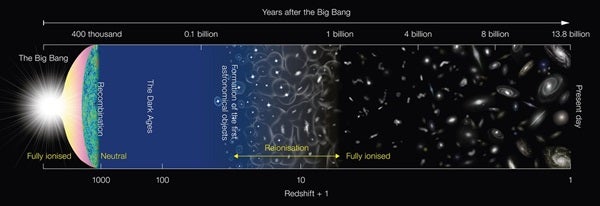The early universe hides behind the cloak of its Dark Ages, a period of time light can’t seem to pierce. Even the length of those unseen years remains uncertain. As part of its efforts to probe the secrets of those hidden years, the European Space Agency’s Planck Satellite recently announced the most precise constraints on the universe’s evasive era, for the first time revealing that the first stars and their galaxies are enough to light up the darkness.
Trying to pierce the veil of darkness has been a decades-long struggle to look back in time nearly 14 billion years. After the Big Bang, the hot universe quickly cooled down, and the simplest atomic particles formed. The protons and electrons of the early universe constantly collided, creating a hot soup that kept light from passing. The Dark Ages had begun.
As the gas cooled down, and the expanding universe stretched space-time, the particles recombined to form neutral hydrogen. Like the rising dawn, the universe grew gradually more transparent, its gradual glow imprinted on the radio noise scientists recognize as the Cosmic Microwave Background (CMB). The universe remained dark, however, because nothing produced visible light.
Gravity worked hard to change that. It didn’t take long for the force to begin pulling material together, forming the first stars and galaxies. Bright galaxies know as quasars, whose central supermassive black holes produce powerful jets of light and matter, also populated the early universe. Heat from the young objects broke the neutral hydrogen apart over time in the process known as reionization, with slow-sweeping bubbles of light spreading outward from the bright objects. As the bubbles grew and overlapped, the universe once again became visible, and the Dark Age ended. (The change of state in hydrogen that allowed a visible universe is called the Epoch of Reionization.)
Perhaps one of the most challenging attributes of the Dark Age is the difficulty inherent in nailing down just when it ended and how long it lasted. Because light didn’t shine from the start of the Dark Age, scientists must rely on the glow from the CMB to provide them with clues to when recombination brought particles together to make the universe gradually more transparent. Observations of early galaxies and quasars, the brightest objects in the universe, help narrow down how long the lights were off.
Planck’s most recent results suggest that the time of reionization, when light from the first objects began to break apart molecules once again, occurred about 55 million years later than previous studies placed it.
“It is certainly clear that we are now measuring a later onset of reionization,” says Planck Project Scientist Jan Tauber said by email.
Planck Scientist Graca Rocha, of the Jet Propulsion Laboratory, stresses that Planck’s measurements have become more precise over time. Rocha, who presented a portion of the research at the American Astronomical Society meeting in San Diego, California in June, pointed to the error bar in the calculations, a number that has grown smaller over time. The most recent results have an error of less than nine-thousandanths.
“We are narrowing the range of reionization, when the first stars start to form,” Rocha told Astronomy. “People are thrilled about the shift down.”
Strange objects begone
The first early estimates suggested that reionization wrapped up extremely fast, requiring unusual astronomical bodies to clear the darkness. Tension mounted as the scientists sought to reconcile multiple forms of observation. Planck’s new numbers helped to relieve some of the pressure as the more precise calculations suggested that novel things were unnecessary after all.
“Those early measurements required ‘strange objects’ to reionize the universe, but those concerns have now been dissipated by Planck,” Tauber says.
“We now know that the first galaxies that we can already observe are enough to reionize the universe at the time shown by the [Cosmic Microwave Background].”
Since its launch in 2009, Planck has probed the early universe, seeking to learn more about when the Dark Ages started and ended. Over three quarters of a decade, the spacecraft has helped to improve the understanding of the unseen era by penetrating the veil of darkness around it.
The more sophisticated analysis reveals that the first objects didn’t begin to separate the fog of particles until “quite late,” Tauber says. Planck reveals that the universe was no more than 10 percent ionized by the time the universe was 475 million years old. It also demonstrated that the process wrapped up quickly, within about 250 million years.
“This model is very consistent with observations of the earliest galaxies,” Tauber says.
These galaxies allow scientists to estimate the total amount of light available to the early universe to split the particles once again.
“So the Planck- and CMB-based estimates are now in full agreement with direct observations.”










